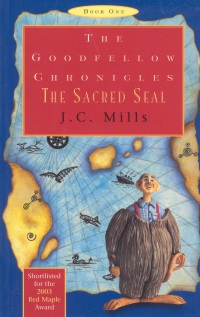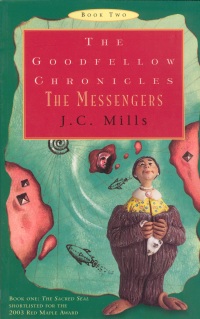| ________________
CM . . .
. Volume X Number 8. . . . December
12, 2003
excerpt:
The first two books of "The Goodfellow Chronicles" by J.C. Mills introduce readers to the ancient Sage clan and to the human family and friends of 10-year-old Sam Middleton. The Sage are tiny human-like creatures who live to be hundreds of years of age, grow to be about six inches tall, and disguise themselves in varieties of mouse costumes in order to move about beneath the notice of human eyes. It is their mission to provide unseen inspiration to humans, "gifted ones," who are marked for acts of courage and genius: Albert Einstein, Charles Lindbergh, Alexander Fleming, Marie Curie, Thomas Edison, Amelia Earhart, Beethoven, Galileo, Rembrandt, Marco Polo and also the missing Professor Hawthorne, in whose bedroom Sam now sleeps since he and his family moved to New England. There is a chain of disappearances in this series that propels the story forward. Each disappearance warrants its own story within the larger mystery of the missing and legendary sacred scroll. Early in Book One, The Sacred Seal, readers meet Jolly Goodfellow, a 900 hundred-year-old Sage who accidentally reveals himself to Sam while working on a mission to find Professor Hawthorne. Mr. Goodfellow is also searching for his young nephew, Edgar, who turns up in Book One, and for Edgar's father, Filbert, who does not. The Sacred Seal chronicles a series of misadventures and conflicts between the forces of Good (The Sage, Sam and his friends) and the forces of Evil (The Fen, supernatural and ancient enemies of The Sage, and the greedy, unscrupulous humans, Professor Mandrake and his son, Basil). Book Two, The Messengers, moves the action to England where Sam and his new friends, Fletcher and India Jaffrey, spend their summer vacation with Auntie Nellie. In The Messengers, Mills explores the mysteries of the legendary scrolls while resurrecting old conflicts between The Fen and The Sage. The cast of characters travels to a world within a world that is linked to the appearance of crop circles in the real world. Some old mysteries are solved, and some new ones are created, suggesting, of course, that there are more books to come in "The Goodfellow Chronicles." However, I am not convinced that this story needed to be spread even over the two existing volumes, each at approximately three hundred pages. The Sacred Seal sets the stage for the adventures that follow in The Messengers as it fills in the background of the disappearances of several key characters. Jolly Goodfellow supplies relevant plot details in a series of rather lengthy narratives. This storytelling device allows the author to inject a heavy dose of history as many of the flashbacks occur during the months leading up to the Second World War. However, the historical episodes read a bit didactically and really slow the pace of the story, giving the impression of very little action. Given the number of references to historical events and figures, a list of sources used or recommended by the author and a list of biographical entries would be useful appendices. The most interesting elements of "The Chronicles," the fantastical characters and their hidden world, seem to take second place to the author's desire to impart some history to young readers. However, this is less true in The Messengers which has a faster pace and contains less extemporizing by Mr. Goodfellow. The Messengers is the better book of the two, but it cannot be read on its own as too much information needed to make sense of the action is given in The Sacred Seal. A recommended strategy is to use Book One as a read-aloud with children, injecting excitement and interest using voice and tone, leaving the faster pace and more linear plot of Book Two for private enjoyment. This leads to my second reservation: these are not young adult novels even though the publisher promotes them as such and The Sacred Seal was short-listed for the Ontario Library Association Red Maple Awards (a pre-selected sample of books are voted on by students in grades seven, eight and nine). The main character is 10-years-old, and notwithstanding the universal appeal of the young Harry Potter, this is the first clue that this series should be aimed at younger readers. The gentle style of story-telling, the fairly banal humour, the lack of typical YA challenges, such as negotiation of identity and finding one's place in the world, also indicate a younger readership for these books. Young adult readers are less likely to endure the incongruencies in the web of fantasy around the Sage characters. The suspension of disbelief falters when one considers the certain visibility of six inch human-like characters dressed in not very realistic looking mouse costumes as shown in the illustrations found throughout both volumes. The use of illustrations also suggests a younger audience. Another reservation is the relatively high price of the books at $15.95 for each paperback. Readers expecting Canadian content will not find it in these volumes. The Sacred Seal and The Messengers are recommended with reservations for a younger audience of children, perhaps as read-alouds to be shared with parents and teachers. The strengths of the books - the unique characterization of Jolly Goodfellow and The Sage clan, the simple conflict between clear-cut, one-dimensional figures of Good and Evil, the straightforward and gentle adventure and mystery elements - will appeal to younger readers. Younger children may also be familiar with some of Mills' picturebooks such as the acclaimed The Stonehook Schooner (1995) and The Painted Chest (2000). Recommended with reservations. Paulette Rothbauer is working on her Ph.D. in Library and Information Science at the University of Western Ontario in London, ON.
To comment
on this title or this review, send mail to cm@umanitoba.ca.
Copyright © the Manitoba Library Association. Reproduction for personal
use is permitted only if this copyright notice is maintained. Any
other reproduction is prohibited without permission.
NEXT REVIEW |TABLE OF CONTENTS FOR THIS ISSUE
- December 12, 2003.
AUTHORS
| TITLES | MEDIA REVIEWS
| PROFILES
| BACK ISSUES
| SEARCH | CMARCHIVE
| HOME |

